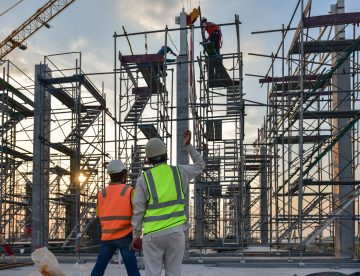
Over a quarter of a million extra construction workers may be needed by 2026, according to the latest Construction Skills Network report. That’s over 53,000 new recruits per year for the next five years!
Published annually by the Construction Industry Training Board (CITB), the report looks into the UK’s construction economy and makes key predictions about what will happen in terms of labour/ skills needs over the coming years.
Check out this week’s blog for more details of what this year’s report had to say plus what it means for the sector and our region.

After a couple of challenging years, many had big hopes that 2022 was going to offer the construction sector a slightly easier path. However, as we now know, the challenges have continued to rain upon our industry – not least of which have been issues around the availability and cost of materials plus labour supply.
More positively, the sector seems to have retained its ability to adapt and love of innovation and these are qualities that can be clearly seen in some of the current architectural design trends. From incorporating more natural lighting to introducing more efficient processes into projects, the design work that’s happening right now is surely leaving its mark on the homes of the future. Keep reading this week’s blog for some of the top trends we’ve come across…

A few weeks ago, we published a blog with some tips about managing and improving something that plays a huge part in every construction project – quality. We looked at how important it is to set out goals, carry out tons of forward planning, create work lists for each and every phase of a project, make inspection plans and to monitor, review and learn from every experience.
However, even with the very best intentions to keep on top of all of this, once a project is underway those intentions can be slipped up and brought to the ground by unexpected obstacles or even by a single mistake that compromises quality and/or safety. As a follow up to our previous blog, today we’re delving into four key factors than can cause such a fall – Systems and audits, Changes, Materials and suppliers, and Human error.

As construction companies continue to face challenges around the supply and cost of materials, the Construction Leadership Council have got together with industry experts to launch a five-point plan to ease the impact.
While many of the factors causing the materials crisis are acknowledged to be outside the control of businesses, experts or even the government, the CLC’s plan seeks to co-ordinate an industry-wide effort to minimise risk and reduce the impact of inflation wherever that’s possible.
Keep reading for more on what’s causing this problem and what’s included in the plan.

Across the world, it’s estimated that around 1.5 billion vehicle tyres are discarded every year. Most of us have probably never really thought about this or what might be happening to such a mountain of tyres once they’ve been cast off. While some may get strung up to a tree to make a swing, such repurposing is really an exception to the rule. In fact, less than one percent of old vehicle tyres are ever reused, meaning huge quantities wind up in stockpiles and landfill.
Now, researchers from the University of South Australia (UniSA) have come up with something that could not only help to resolve the landfill problem but also provide an economically viable and sustainable alternative to concrete for the construction industry. Read this week’s blog for more about this exciting development.

The term ‘quality’ can mean different things to different people – the secret to achieving high standards; a measure that we use to evaluate ourselves and others; or a complex set of criteria, controls and procedures that our professional work must adhere to.
For a simpler definition, quality is really all about what separates the good from the bad. For construction projects and businesses this couldn’t be more important, so today we’re going to dive into why that is exactly as well as offer a few tips for how to manage and improve quality.

(Mental Health Awareness Week 2022)
After two years of the pandemic, where there has been much less direct contact with friends, family, colleagues or even with essential healthcare professionals, many people are feeling a greater sense of loneliness, isolation and disconnection from our altered society.
Responding to this, the Mental Health Foundation have chosen ‘loneliness’ as the theme of this year’s Mental Health Awareness Week which starts today. With construction workers being exposed to many of the same stress points in life as everyone else, we’re using this week’s blog to talk about loneliness in detail and provide a few tips as to what can be done to manage or overcome this problem.

With soaring energy prices, interest rate rises, some huge hikes in the cost of materials and the continuation of labour shortages, many construction industry businesses could be in for some turbulent times this year.
In many cases, the cost pressures are made worse by the fact that contractors are both tied into existing work which was based on estimations set well before the current price rises and are also busy looking at how they can respond to invitations to tenders in ways that make the jobs viable within the current circumstances. In today’s blog, we’re taking a look at what construction businesses (and those who work within them) can do to face this challenge.

In new rules which came into place on Friday 1st April, the government has stated that construction firms in the UK can no longer use red (rebated) diesel for site plant and machinery.
Brought in as part of the search for policies which will help the country hit its net zero target by 2050, this would seem like a good thing. However, looking at the impact this is likely to have on construction companies in the current economic circumstances, many in the industry are calling this ‘the right policy at the wrong time’. Here’s what you need to know…

